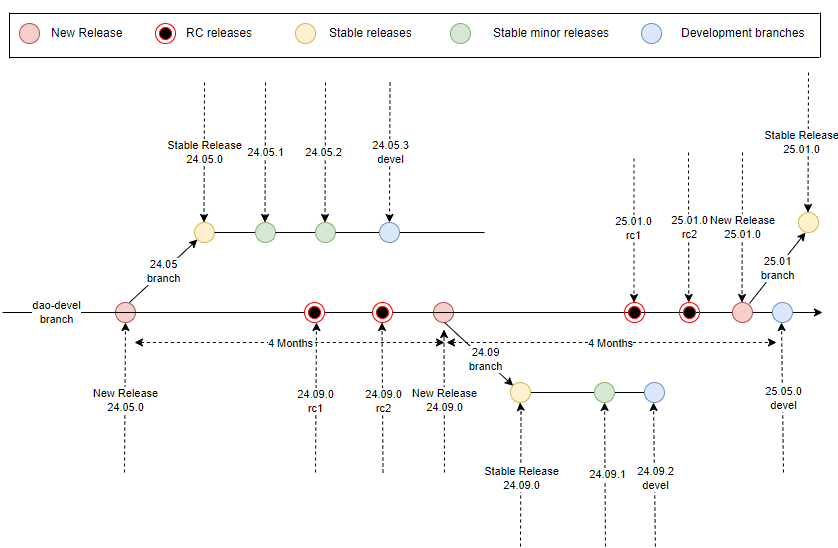3. DAO Release Process#
DAO release process is a structured procedure that involves the periodic
roll out of stable versions every Four months. This systematic approach
ensures structured and efficient progression of updates and improvement.
It provides ample time for contributors to review, discuss, and enhance
their contributions.
The four-month span is strategically segmented in four stages:
Stage 1: The initial 45 days are dedicated to new proposals, including RFCs and features.
Stage 2: Next 45 days targeted for API freeze. After approximately 90
days of release cycle, RC1 release will be available.
Stage 3: Subsequently, a 15-day window will commence for the application
feature freeze, followed by roll out of the RC2 release.
Stage 4: During the final 15 days, the emphasis will be on merging only bug fixes, culminating in the availability of the final release.
Upon the completion of the four-month cycle, a stable release is diligently prepared and made accessible to the user.
The merge window swings open immediately following the completion of a stable release, maintaining the momentum of progress.
Stable releases are maintained in parallel, with essential patches being backported to ensure a seamless and uninterrupted user experience. This approach ensures that users of the stable release continue to benefit from critical updates without compromising the stability of their systems.
3.1. Release Flow#
The following diagram provides a visual representation of our release cycle, illustrating the key stages and timelines involved in the process:

3.2. Software Versioning#
A typical DAO software version adheres to the format:
<year>.<month>.<minor number>
where each component signifies a specific aspect of the release i.e. the
year and month represent the release date, while the minor number
indicates the iteration within that release cycle.
Eg. 24.05.0 signifies a release from May 2024.
The ‘0’ in the above version number signifies the initial stable release of the
cycle. This digit is systematically incremented whenever enhancements such as
hotfixes, significant features, or bug fixes are backported, reflecting the
evolution of the software within the stable release cycle
3.3. Package Format#
The filename or syntax of a typical release binary is as follows, serving as a standard format for each release:
dao-<platform>_<version>_<arch>.<package>
Eg. dao-cn10k_24.05.0_arm64.deb
where
cn10k - targeted SOC
24.05.0 - software version
arm64 - architecture
deb - Debian package
During the development phase of a new release, the generated package distinctly
includes the keyword devel in its name.
Eg. dao-cn10k-devel_24.09.0_arm64.deb
This practice extends to stable releases as well, where the devel variant
signifies the dynamic branch that accommodates backported patches, thereby
reflecting the ongoing maintenance of the stable release.
Eg. dao-cn10k-devel_24.05.2_arm64.deb
Note
From package name dao-cn10k-devel_24.05.2_arm64.deb, following can be
interpreted:
Its a May 2024 release with initial release packaged as
dao-cn10k_24.05.0_arm64.debOne minor release is also rolled out
dao-cn10k_24.05.1_arm64.deb.The ongoing minor release, i.e. version 2, is currently in the development phase and has not yet been released. This is branch to which patches will be backported.
3.4. Stable Release Maintenance#
Once a release is rolled out, parallel branches/tags are strategically created with an objective of maintaining DAO releases, incorporating backported fixes over an extended duration.
This approach offers downstream consumers of DAO a stable foundation for building applications or packages, ensuring reliability and consistency.
3.4.1. What changes should be backported#
Stable releases are primarily characterized by their dedication to resolving issues and preventing the introduction of new regressions. Simultaneously, they uphold backward compatibility with the initial release of the stable version, ensuring a seamless user experience across updates.
Minor bug fixes that bolster stability, patches for critical bugs are prioritized as the first candidates for backporting.
In certain exceptional scenarios, it might be deemed acceptable to backport a new feature to a stable release, thereby enhancing its functionality while maintaining its stability.
Note
DAO follows same ABI Policy as DPDK
Several factors influence the decision to backport a patch, such as:
Should not break ABI/API
Should not compromise on backward compatibility
Scope of the code change
It is fixing a performance regression that occurred previously.
3.4.2. Bumping a new stable release#
Upon backporting all pertinent bug fixes, regression tests are executed. If these tests yield positive results, the announcement of the new minor stable release is made.
Following are some factors influencing new minor release
After accumulating 10-15 minor bug fixes
Critical bug fixes
Change in dependent package version i.e. if dependent package eg DPDK is upgraded.
Exceptional new features
3.5. Steps involved in rolling out a release#
When the four-month cycle for a new release is nearing its end, or in the case of a stable release, when any of the aforementioned criteria for rolling out a new release are met, a series of steps are initiated to make the new release available:
Tag the release with YY.MM.n (year, month, number).
Update the respective version number for upcoming development branches
Execute all unit tests, integration tests, stability tests
Update the release notes with new features, improvements
Publish the new release
